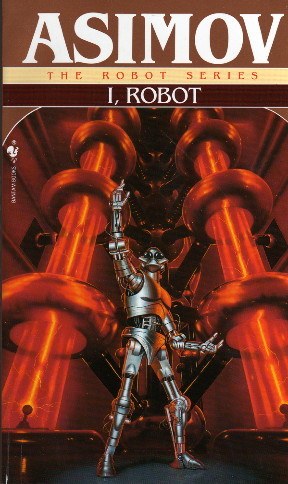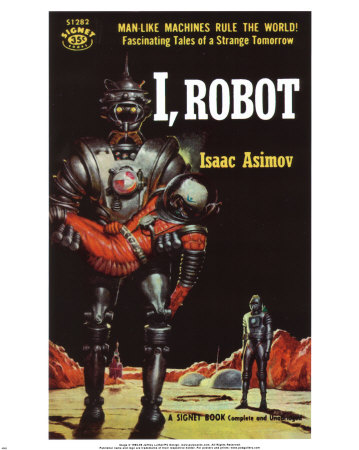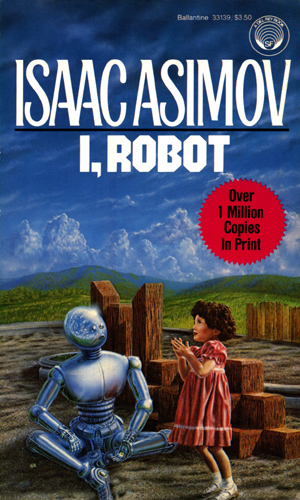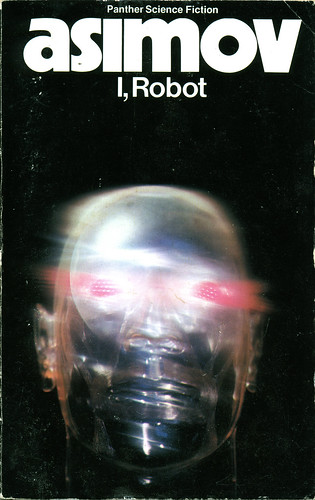“I, Robot” by Isaac
Asimov,1950
“I, Robot” is a collection
of nine (9) stories loosely threaded together throughout the life of one
scientist, a “Robopsychologist” named Susan Calvin under the employ of U.S.
Robots and Mechanical Men, Inc. The story is delivered through the narration of
a reporter, as told by Susan Calvin in the 21st century.
This novel also shares the
name of a movie released in the year 2004, starring Will Smith, called “I,
Robot”. The movie was inspired and borrows from “Little Lost Robot”, some of
Asimov’s character’s names, and the “Three Laws of Robotics.” The similarities
end there and the movie, for the most part, is original from the book.
Each story involves a witty
premise in which the “Three Laws of Robotics” are stretched to a breaking point
and causes aberrant behavior in the robot, leaving the protagonist(s) in search
of logical explanations to solve the problem.
The individual stories share
themes of morality, and examine the interactions and relationship between
humans and machines from the time when robots were relatively crude mute
household appliances to when they grow into lifelike androids indiscernible
from humans. Combined, the series of vignettes tell a larger story of Asimov’s
history of robotics.
The short stories are:
“Robbie”- A touching story
about a little girl’s attachment to her mute, appliancelike robot, is simply
splendid and my favorite.
“Runaround” – We meet a pair
of field testers of new robot model, Donovan and Powell, who are almost
stranded on Mercury when a new robot model has trouble reconciling the Second
and Third Laws. The robot is described as seeming to behave intoxicatedly, and
with that, sets a farcical tone to the story.
“Reason” – A robot becomes
fanatically religious and refuses to believe that weak and frail humans are its
creator.
“Catch that Rabbit” –
Donovan and Powell troubleshoot a “multiple-robot”, a set of mechanical workers
with one master robot controlling six subordinate parts.
“Liar” – A robot factory
accidentally creates a mind-reading robot and Susan Calvin tries to determine
how this happened. The story also explores what happens when what people say
and think (mean) are not the same things.
“Little Lost Robot” – A
potentially dangerous military robot whose First Law has been slightly altered
is hiding among a shipment of physically identical robots. Susan Calvin tries
to determine which robot is the dangerous one.
“Escape” – A mischievous
robot send Donovan and Powell unwillingly on an intergalactic test flight. Susan
Calvin must convince the jovially mischievous robot into returning them home.
“Evidence” - A short story
positing the existence of difference between robots and politicians contains
neat twist in the end and ranks in as my second favorite.
“The Evitable Conflict” –
Delivered as a conversation between humans analysts, consider the consequences
of turning over control of the global economy to the Machines, was for me, dull
and uninteresting.
Here, are Asimov’s lasting
and famous “Three Laws of Robotics” introduced in this book:
1. A robot may not injure a
human being or, through inaction, allow a human being to come to harm.
2. A robot must obey any
orders given to it by human beings, except where such orders would conflict
with the First Law.
3. A robot must protect its
own existence as long as such protection does not conflict with the First or
Second Law.
My rating: ★★★★☆ (4 out of 5 stars) - I really liked it.
Related art from various sources on the internet:





i have a question:
ReplyDeleteis the authors purpose primarily emotional or expressive, intellectual, representational or literary?